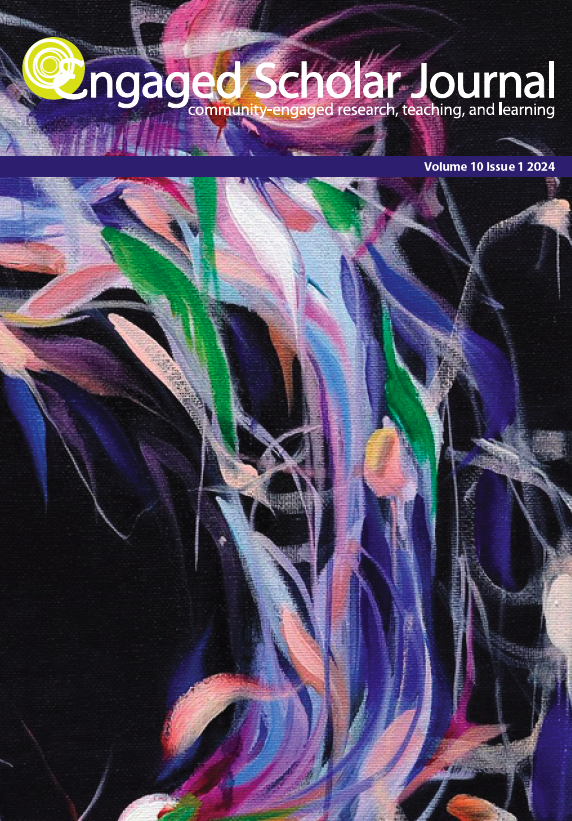Silence: A Novel Co-Produced Experience To Build Community Awareness Of Biodiversity Loss
DOI:
https://doi.org/10.15402/esj.v10i1.70861Keywords:
biodiversity loss, co-production, community conservation, experiential sound, sonic worldAbstract
The current sounds of our world are under threat of disappearing. Undergraduate students and interdisciplinary university teams are at the forefront of generating collaborative research opportunities to create community awareness of biodiversity loss and conservation practices. Recent conservation research has focused on how local communities can begin to reverse the trends of biodiversity loss by using private residences and urban spaces. The inclusion of native plants in backyard gardens is an accessible way to promote ecological restoration. In this co-produced instructional exhibit, “Earth Day Celebration: Silence,” we introduce a novel experiential event that connects instructional design with community collaboration. The event was designed to explore the ways in which society can become engaged in the preservation and protection of biodiversity and our sonic world.
References
Anderson, A. G., Messer, I., & Langellotto, G. A. (2021). Gardeners’ perceptions of northwestern U.S. native plants are influenced by ecological information and garden group affiliation. HortTechnology, 31(4), 458–469. https://doi.org/10.21273/HORTTECH04770-20
Barber, J. R., Crooks, K. R., & Fristrup, K. M. (2010). The costs of chronic noise exposure for terrestrial organisms. Trends in ecology & evolution, 25(3), 180-189. https://doi.org/10.1016/j.tree.2009.08.002
Beckwith, B. R., Johansson, E. M., & Huff, V. J. (2022). Connecting people, plants and place: A native plant society’s journey towards a community of practice. People and Nature, 4(6), 1414–1425. https://doi.org/10.1002/PAN3.10368
Burghardt, K. T., Tallamy, D. W., & Gregory Shriver, W. (2009). Impact of native plants on bird and butterfly biodiversity in suburban landscapes. Conservation Biology, 23(1), 219–224. https://doi.org/10.1111/J.1523-1739.2008.01076.X
Callaghan, C. T., Borda-de-Água, L., van Klink, R., Rozzi, R., & Pereira, H. M. (2023). Unveiling global species abundance distributions. Nature Ecology & Evolution, 7(10), 1600–1609. https://doi.org/10.1038/s41559-023-02173-y
Carson, R. (1962). Silent spring. New York, Fawcett Crest.
Ceballos, G., Ehrlich, P. R., Barnosky, A. D., García, A., Pringle, R. M., & Palmer, T. M. (2015). Accelerated modern human-induced species losses: Entering the sixth mass extinction. Science Advances, 1(5), e1400253–e1400253. https://doi.org/10.1126/sciadv.1400253
Delahay, R. J., Sherman, D., Soyalan, B., & Gaston, K. J. (2023). Biodiversity in residential gardens: A review of the evidence base. Biodiversity and Conservation, 32(13), 4155–4179. https://doi.org/10.1007/S10531-023-02694-9
Ditchkoff, S. S., Saalfeld, S. T., & Gibson, C. J. (2006). Animal behavior in urban ecosystems: Modifications due to human-induced stress. Urban ecosystems, 9, 5-12. https://doi.org/10.1007/s11252-006-3262-3
Intergovernmental Science-Policy Platform on Biodiversity and Ecosystem Services (IPBES). (2019). Global assessment report on biodiversity and ecosystem services of the Intergovernmental Science-Policy Platform on Biodiversity and Ecosystem Services. E. S. Brondizio, J. Settele, S. Díaz, and H. T. Ngo (eds.). IPBES. https://doi.org/10.5281/zenodo.3831673
Lerman, S. B., Larson, K. L., Narango, D. L., Goddard, M. A., & Marra, P. P. (2023). Humanity for habitat: Residential yards as an opportunity for biodiversity conservation. BioScience, 73(9), 671–689. https://doi.org/10.1093/BIOSCI/BIAD085
Pijanowski, B. C., Farina, A., Gage, S. H., Dumyahn, S. L., & Krause, B. L. (2011). What is soundscape ecology? An introduction and overview of an emerging new science. Landscape ecology, 26, 1213-1232. https://doi.org/10.1007/s10980-011-9600-8
Rudd, H., Vala, J., & Schaefer, V. (2002). Importance of backyard habitat in a comprehensive biodiversity conservation strategy: A connectivity analysis of urban green spaces. Restoration
Ecology, 10(2), 368–375. https://doi.org/10.1046/J.1526-100X.2002.02041.X
Simkin, R. D., Seto, K. C., McDonald, R. I., & Jetz, W. (2022). Biodiversity impacts and conservation implications of urban land expansion projected to 2050. Proceedings of the National Academy of Sciences of the United States of America, 119(12), e2117297119.
https://doi.org/10.1073/PNAS.2117297119/SUPPL_FILE/PNAS.2117297119.SD02.XLSX
Sordello, R., Ratel, O., de Lachapelle, F. F., Leger, C., Dambry, A., & Vanpeene, S. (2020). Evidence of the impact of noise pollution on biodiversity: A systematic map. Environmental Evidence, 9(1), 1–27. https://doi.org/10.1186/S13750-020-00202-Y
Tallamy, D. W. (2004). “Do alien plants reduce insect biomass?” Conservation Biology, 18(6), 1689–
https://doi.org/10.1111/j.1523-1739.2004.00512.x
Tallamy, D. W. (2007). Bringing nature home: How you can sustain wildlife with native plants. Portland, Oregon. Timber Press.
Tallamy, D. W. (2019). Nature’s best hope: A new approach to conservation that starts in your yard. Portland, Oregon. Timber Press.
Wania, A., Kühn, I., & Klotz, S. (2006). Plant richness patterns in agricultural and urban landscapes in central Germany: Spatial gradients of species richness. Landscape and Urban Planning, 75(1–2), 97–110. https://doi.org/10.1016/J.LANDURBPLAN.2004.12.006
Wiederholt, R., Trainor, A. M., Michel, N., Shirey, P. D., Swaisgood, R. R., Tallamy, D., & Cook-Patton, S. C. (2015). The face of conservation responding to a dynamically changing world. Integrative Zoology, 10(5), 436–452. https://doi.org/10.1111/1749-4877.12151
Downloads
Published
How to Cite
Issue
Section
License
Copyright (c) 2024 Kristen Bellisario, Christie Shee

This work is licensed under a Creative Commons Attribution 4.0 International License.
Authors who publish with this journal agree to the following terms:
- Authors retain copyright and grant the journal right of first publication with the work simultaneously licensed under a Creative Commons Attribution License CC BY 4.0 that allows others to share the work with an acknowledgement of the work's authorship and initial publication in this journal.
- Authors are able to enter separate, additional contractual agreements for the non-exclusive distribution of the journal's published version of the work (e.g., post it to an institutional repository or publish it in a book), with an acknowledgement of its initial publication in this journal.
- Authors are permitted to post their work online (e.g., in an institutional repository or on their website) after the publication of their work in the Engaged Scholar Journal.
- Please note that while every opportunity will be taken to ensure author participation in the editing process, due to time constraints final copyediting changes may be made before publication to ensure APA adherence throughout all submissions.




